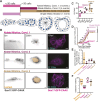Specific mitotic events drive left-right organizer development
- PMID: 40230260
- PMCID: PMC12148018
- DOI: 10.1242/dev.204687
Specific mitotic events drive left-right organizer development
Abstract
Cell proliferation is crucial for tissue development. Here, we investigate its role in the left-right organizer, which establishes the left-right axis. In zebrafish, we mapped mitotic events in Kupffer's vesicle (KV) and identified an anteriorly enriched, FGF-dependent mitotic pattern. Laser ablation of mitotic cells and pericentrin-null mutants, both reducing mitotic events, resulted in smaller lumens, confirming that cell division is essential for KV development. Pericentrin-null mutants also exhibited defects in leftward cardiac jogging, indicative of KV dysfunction. Using a KV-specific fluorescent microtubule marker, we found that the KV rosette is a transient, centrally organized cluster interconnected by cytokinetic bridges and containing microtubule bundles. This structure emerges after the first four divisions and precedes lumen formation. Mitotic events during KV rounding coincide with rosette formation, spindle rotation and cell extrusion, likely driven by increased packing. Eliminating the first four mitotic events disrupted rosette formation and prevented normal KV rounding. These findings demonstrate that mitotic events are crucial for KV development, with cell division timing shaping KV architecture and function.
Keywords: Cell patterning; Cilia; Cytokinesis; Left-right organizer; Lumen formation; Microtubules; Mitosis; Rosette.
© 2025. Published by The Company of Biologists.
Conflict of interest statement
Competing interests The authors declare no competing or financial interests.
Figures








Update of
-
Specific Mitotic Events Drive Cytoskeletal Remodeling Required for Left-Right Organizer Development.bioRxiv [Preprint]. 2024 Oct 1:2024.05.12.593765. doi: 10.1101/2024.05.12.593765. bioRxiv. 2024. Update in: Development. 2025 May 15;152(10):dev204687. doi: 10.1242/dev.204687. PMID: 38798489 Free PMC article. Updated. Preprint.
Similar articles
-
Specific Mitotic Events Drive Cytoskeletal Remodeling Required for Left-Right Organizer Development.bioRxiv [Preprint]. 2024 Oct 1:2024.05.12.593765. doi: 10.1101/2024.05.12.593765. bioRxiv. 2024. Update in: Development. 2025 May 15;152(10):dev204687. doi: 10.1242/dev.204687. PMID: 38798489 Free PMC article. Updated. Preprint.
-
Organized chaos in Kupffer's vesicle: how a heterogeneous structure achieves consistent left-right patterning.Bioarchitecture. 2014;4(3):119-25. doi: 10.4161/19490992.2014.956593. Bioarchitecture. 2014. PMID: 25454897 Free PMC article.
-
Rab8, Rab11, and Rab35 coordinate lumen and cilia formation during zebrafish left-right organizer development.PLoS Genet. 2023 May 15;19(5):e1010765. doi: 10.1371/journal.pgen.1010765. eCollection 2023 May. PLoS Genet. 2023. PMID: 37186603 Free PMC article.
-
Left-right asymmetry in zebrafish.Cell Mol Life Sci. 2012 Sep;69(18):3069-77. doi: 10.1007/s00018-012-0985-6. Epub 2012 Apr 19. Cell Mol Life Sci. 2012. PMID: 22527718 Free PMC article. Review.
-
The maternal coordinate system: Molecular-genetics of embryonic axis formation and patterning in the zebrafish.Curr Top Dev Biol. 2020;140:341-389. doi: 10.1016/bs.ctdb.2020.05.002. Epub 2020 Jun 16. Curr Top Dev Biol. 2020. PMID: 32591080 Review.
Cited by
-
Basal Cell-Contact Dynamics Influence Tissue Packing in a Proliferating Mammalian Epithelium.bioRxiv [Preprint]. 2025 Jul 31:2025.07.30.665610. doi: 10.1101/2025.07.30.665610. bioRxiv. 2025. PMID: 40766584 Free PMC article. Preprint.
References
-
- Abdel-Razek, O., Marzouk, A., MacKinnon, M., Guy, E. T., Pohar, S. A., Zhushma, E., Liu, J., Sia, I., Gokey, J. J., Tay, H. G.et al. (2023). Calcium signaling mediates proliferation of the precursor cells that give rise to the ciliated left-right organizer in the zebrafish embryo. Front. Mol. Biosci. 10, 1292076. 10.3389/fmolb.2023.1292076 - DOI - PMC - PubMed
-
- Aljiboury, A. A., Ingram, E., Krishnan, N., Ononiwu, F., Pal, D., Manikas, J., Taveras, C., Hall, N. A., Da Silva, J., Freshour, J.et al. (2023). Rab8, Rab11, and Rab35 coordinate lumen and cilia formation during zebrafish left-right organizer development. PLoS Genet. 19, e1010765. 10.1371/journal.pgen.1010765 - DOI - PMC - PubMed
MeSH terms
Substances
Grants and funding
LinkOut - more resources
Full Text Sources
Research Materials

